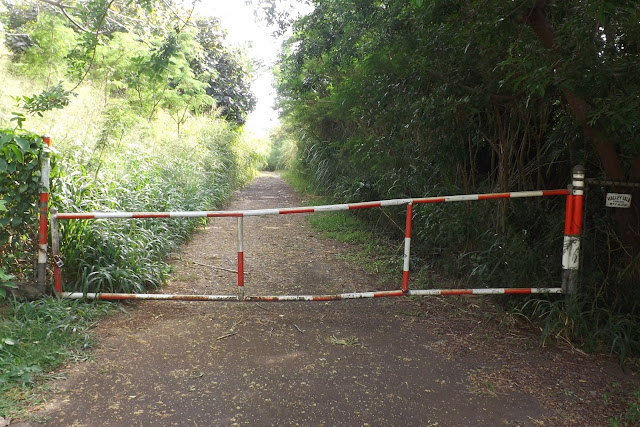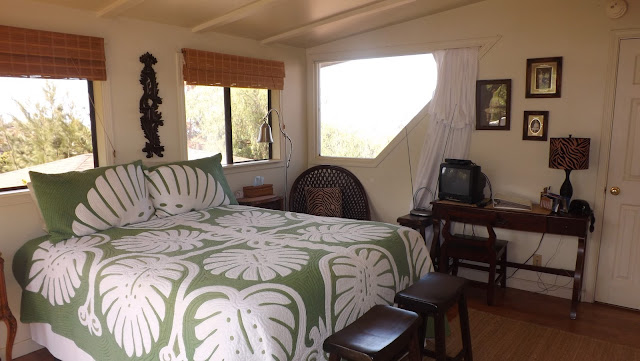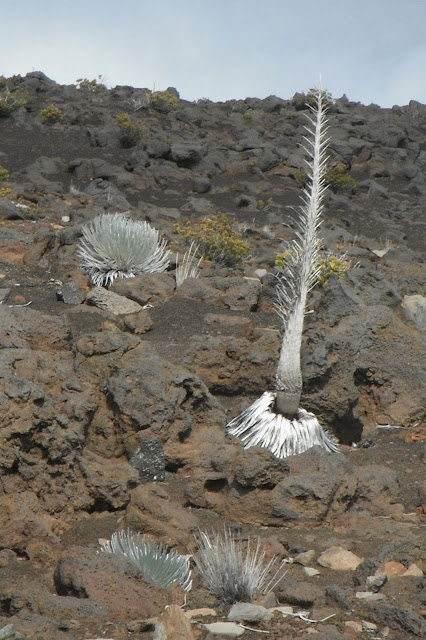MAUI 2013 – EAST MAUI
It was time to extend the research for
my book to Maui and I had to figure out the most practical location to investigate both
native plants and birds. Rather than the
West Maui watershed or the East Maui forest restricted
from the public, I sought out Waikamoi Gulch on land belonging to The Nature Conservancy (TNC) just outside the Haleakala park boundary (yellow arrow on map on previous post).
Day 4 –
Moliko Iki
The closest lodging is at Kula where
we booked a B&B. Leaving the ocean
below we had one detour to make before checking in. Gil has another paddle buddy named Brian
McCafferty that has a big project going near Pa’ia and another big project
between Pa’ia and Haiku.
We went to his base camp where he guides
teenagers as work crews. They have gardening accounts, do construction
demolition, large scale composting, and recycling. The program is TEENS ON CALL /
TEENFORCE. There is a classroom where high
school and/or GED kids actually learn trades skills while earning money. It is very ambitious with buildings,
equipment, and designated project areas scattered over 5 acres with a
traditional stone-walled, grass topped hula platform in the middle reflecting the importance of the Hawaiian culuture. This was great and we were really interested
in the valley he is restoring off Moliko Gulch called Moliko Iki Farm. Off we
went in Brian’s van.
We parked and walked in. The road needs continual maintenance to
remain free of greenery. Most of what we
saw growing was introduced: java plum, strawberry guava, and basically what we
all consider junk trees. After
everything of value was removed (sandalwood, hardwoods, etc.) in the 1800s,
reforestation throughout the islands was done poorly with fast growing but
aggressively invasive plants that have changed the landscape beyond
recognition.
Gate to Moliko Iki Farm
Brian’s dream is to clear enough of
the 65 acres he leases from Alexander & Baldwin (of previous sugar cane
reign) to restore it to pre-contact times with all the cultural richness of the
Hawaiian lifestyle.
Taro is beginning to come up along the stream on its own
the kids actually harvest the leaves to sell - delicious cooked as greens
Not in production right now, little by little the Lo'i or taro patches are uncovered from the past
Gil & I in the valley of hope and dreams
More stream taro
It has taken Brian about five years of
intermittent attention to find and to clear some of the original terracing. There is an 80 foot
waterfall on the property and a couple caves.
There is mystery and legend emerging just as the rocks
show themselves between the grass and tree roots.
One of Brian's dreams is to guide educational tours through here. We picked up a bucket load of lilikoi or passion fruit at the base of the valley on our big loop. He wanted us to see the stairs he and the
kids had put in. I confess, I imagined a
half dozen steps rather than this stairway to heaven. Wow!
Brian and Gil on the stairway to the Pleiades
Close to the road out, we found ripe breadfruit and along with our
bag of lilikoi, we were ready for the B&B and our mountain adventure.
We drove up to Kula View B&B and
were happy to have a dwelling for the next three days that would give us
breathing room. We had views of both
the ocean below and up the mountain shrouded in cloud. That night we went to sleep looking at the new
moon and millions of stars.
Kula View B&B
Interior very pleasant and comfortable
Kula means plains and the gentle slop up the mountain is traditionally agriculture land. The land across the neck of Maui
will one day be under water as the seas rise, but for now it is quite charming.
Looking down to sea level, both sides
We hadn’t eaten since breakfast in Pa’ia (crepes at Des Amis) and
we still had to buy groceries as there are no services or food at
Haleakala. We had a nice dinner at Kula
Bistro and got provisions at Morihara’s.
We had to acclimate to both altitude and temperature changes, there can be 40 degree difference from sea level to the summit.
Day 5 – Haleakala National Park
It takes almost an hour drive to the park
entrance from Kula, up miles of switchbacks. The B&B provided heavy ski jackets for
the cold, both size extra large! Gil’s fit
and I didn’t care that mine was huge. I was literally nearly blown off the mountain once
when I had my backpack casually over one shoulder and the wind caught it.
Gil made fun of my stance (so I wouldn't blow over)
and the grimace that was supposed to be a smile while I tried to stop chattering teeth!
Haleakala
So the story is, that this is not the crater but rather the original vastness now filled
from the spew of each of these individual cones
Wicked wind, not dirt or sand, but cinders
The valley is truly vast
There is a lot to take in with the
phenomenal geological time and the hardship of the wildlife here. The summit features several scrubby plants that
struggle for survival. The remains of a volcano are seen as the relics of cones, depths of cinders, but also fields of
basalt. Whether the park
uses them to make walls or the Hawaiians used them for adzes, tons lie about.
Field of basalt
The green plants are called N'aen'ae (nah-eh nah-eh)
the little bunch grass is also an endemic
Na'ena'e
The entrance to the park is 7,000’
elevation and the summit is at 10,000,’
a few more serious switchbacks.
Along the way are the famous silver sword plants of Haleakala. We did not catch the dramatic blooming season
but the strange and beautiful plants capture your imagination as mountain
urchins. They grow
anywhere from 5-50 years before blooming – and then die. Truthfully I preferred seeing them in their
prime. Gil got these first two shots while I was in Waikamoi.
Haleakala Silversword - grows nowhere else
This tall stalk is the skeleton of a flower that bloomed last year, the plant has died
They are quite dramatic in bloom as the end of each branch has a little sunflower (same family)
I'm fond of this stunning little beauty,
planted outside of the first visitor center
The other hardy and amazing creature
of the crater is the endemic Hawaiian
Petrel. This endangered 17” sea bird
is large for a petrel, black above and white below. It is difficult to study,
rarely seen at sea where it lives roaming the Pacific. While it may breed on Kauai, Lana’i, and the Big Island ,
the largest colony is at Haleakala crater
where it digs burrows into the cinders for nesting. As a night fisher, it is not seen during the
day. There are only an estimated 4500
breeding pairs remaining. The Hawaiian
name is ‘Ua’u (oo-wa-oo) which is the call it makes.
Haleakala is also haven for the state bird of Hawaii Kauai (without the heavy
mongoose as predator) I only saw two of the little geese all week.
OK, now I’m back to my mission, forest birds and plants. Heading back down from
the main visitor center we stopped at an overlook with timberline below. We realized it was probably Hosmer Grove we
were looking at. Hosmer was put in
charge of reforestation after the land had been clear cut and the not so wise
opportunists realized they would have serious erosion control problems. His task was two-fold, stabilize the erosion
and experiment with forestry that would produce lumber. Rather than planting the native sandalwood,
koa and ohia trees, varieties of eucalyptus and conifers were tried instead.
Hosmer Grove from
above
At 8800' we are still in scrubland but the conifers are obvious below
It is clearly in the cloud belt, a regular condition not just a storm
Hosmer Grove today is about half timber experiment and about half
native scrubland plants. Fortunately for
me, the honeycreepers love the scrubby mamane that is here. My
forest bird research has all been in Koke'e on Kauai and in Volcano National Park
on the Big Island
Hosmer grove - out of the tall pines and eucalyptus and into the mamane
Looking up toward the mountain we had just come down
There were little guys zooming everywhere
I think both of the bottom ones are the 5" red apapanes,
one like a torpedo the other with wings open
No idea who the one at the top is - there were probably at least this many outside of the frame
This little I'iwi was singing
my camera focused on the branch I didn't even see
I'iwi eating nectar from a mamane flower
Close up of Mamane (ma-ma-neh)
Quite appealing to a nectar loving honeycreeper
While not nearly so windy and cold as the top, it was getting late
and the mists came and went. It was hard
to leave even though we would be back tomorrow morning for the hike into Nature
Conservancy lands that begin just past Hosmer.
I'iwi landing on mamane branch
These are not photo contest pics but to catch these rare little birds so active among native plants in the common condition of shrouding mists, was quite a thrill for me
Day 6 –
Wakamoi Cloud Forest Hike
Dressed in long johns and polar tec
with a hat that covered my ears (but not the marshmallow coat) I was ready for
the mountain. There were some serious
birders and a family with two young girls.
It was led by a young lady named Katelyn, not from the nature conservancy but from
the park service. She had a very relaxed but confident style of
leading; she stopped and gathered people up to explain elements of the forest
from the cause of the mist at our present elevation to the adaptive radiation
of the finches. Since I had asked about
native plants, she pointed out several I was interested in, sometimes waiting for me if I was at the back of the pack rather than the front to make sure I got what I wanted.
We went through the conifers as expected and
as we descended we got into the more native koa and ohia mixed with
mamane. Moving down the side of the gulch provided great visibility while
being surrounded by forest. In both
Koke'e and Volcano I hear the birds but they are in the dense canopy
overhead. Here I could at least see the
quick moving characters busily earning a living, eating, flying from one tree
to the next at eye level even if across the valley.
We had a moment of clear sight to sea level, 6500' below here
The conifers are pointed, the foreground trees are the native 'ohia lehua that have red nectar-rich pompom flowers. In the center are Koa, with crooked trunks - they house insects, especially when they host lichen.
Apapane eating from a Lehua flower
We are seeing his back end with the white panties (apa-panties as Katelyn says)
His bill is buried in the blossom
Apapane in flight
Not sure if the bit of red I was seeing was a bird or more red flowers,
he surprised me when he took off
he surprised me when he took off
Amakihi in 'ohia
His thin curved bill is visible at the top of his head even though we are viewing his back
The red birds may trick us among the red flowers,
but the little green guys are really tricky among green leaves, what fun!
The bottom for us was just where the stream
bed was exposed. I would like to go deeper another time.
The trail is sunlit at lower center, the rocks are the stream bed of Waikamoi Gulch
dry today, when it rained a couple weeks ago it was raging
Waikamoi stream bed
Lobelia Grayana - a rare endemic plant on far left, developed with curved bill of honeycreepers
Lobelia Grayana - a rare endemic plant on far left, developed with curved bill of honeycreepers
Native ama'u ferns along rock wall above stream bed
The mist rolled in, even a couple drops of rain
Laka is the goddess of the forest
Laka is the mist
I had expected to go back the way we came but after our snack break, we climbed up a steep hill and returned on a pleasant loop. We didn't dally on the way back but Katelyn remembered to point out plants she thought I would like to note. I will return to Waikamoi next Maui trip. Thanks,
Nature Conservancy!







































No comments:
Post a Comment